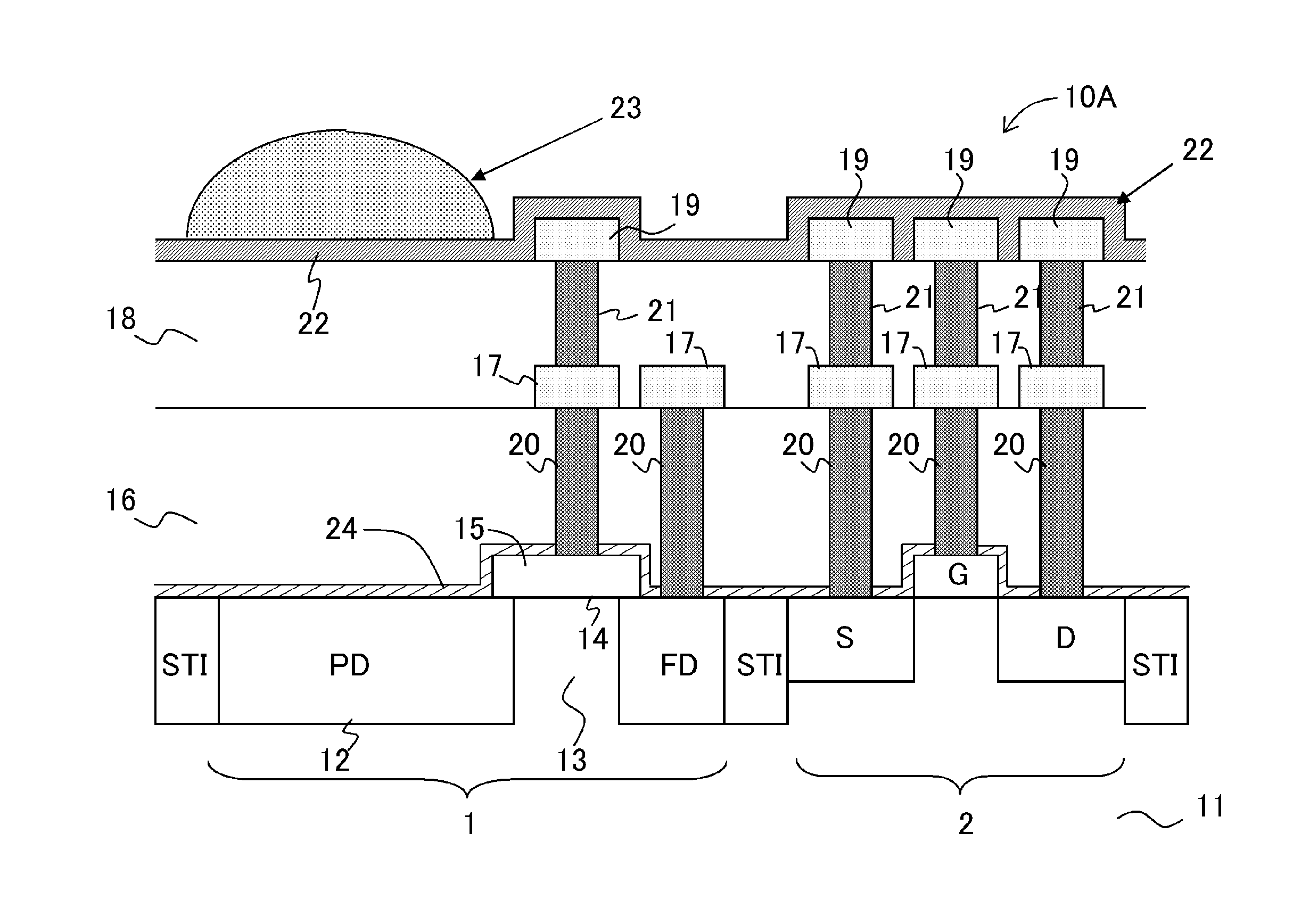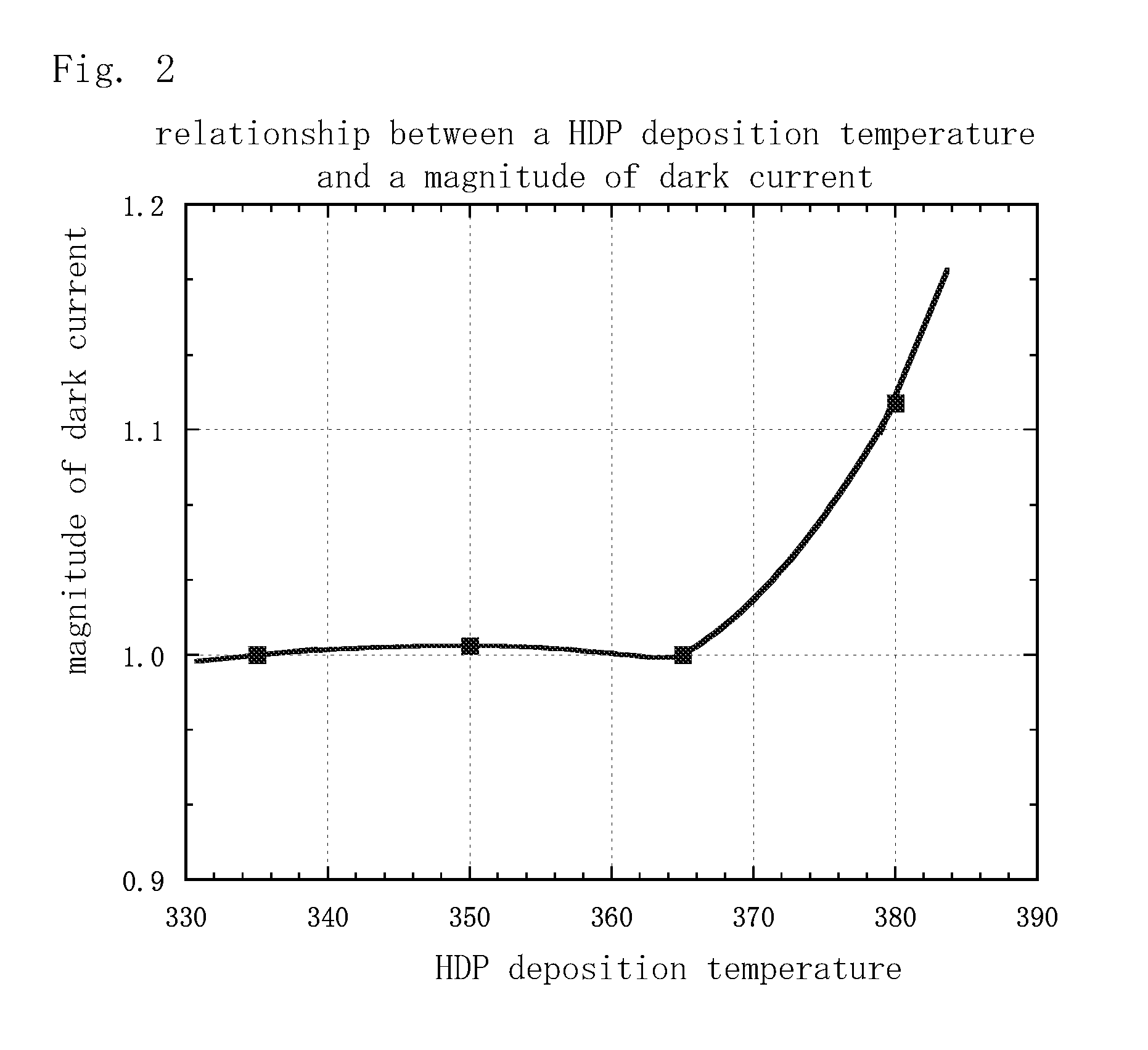Method for manufacturing a solid-state image capturing element
a solid-state image and manufacturing method technology, applied in the direction of chemical vapor deposition coating, radiation control devices, coatings, etc., can solve the problems of picture quality deterioration and signal deterioration, and achieve the effect of preventing deterioration of picture quality, reducing signal deterioration, and increasing fine white defects
- Summary
- Abstract
- Description
- Claims
- Application Information
AI Technical Summary
Benefits of technology
Problems solved by technology
Method used
Image
Examples
embodiment 1
[0074]FIG. 1 is a longitudinal cross sectional view schematically illustrating an exemplary essential part structure of a CMOS solid-state image capturing element according to Embodiment 1 of the present invention.
[0075]In FIG. 1, a photodiode 12 is formed as a surface layer of a semiconductor substrate 11 in each pixel section 1 of a CMOS solid-state image capturing element 10 according to Embodiment 1. The photodiode 12 functions as a photoelectric conversion section (light receiving element) for each pixel. Adjacent to the photodiode 12, an electric charge transfer section 13 is provided in an electric charge transfer transistor for transferring a signal charge to a floating diffusion section (electric charge voltage converting section) FD. Above the electric charge transfer section 13, a transfer gate 15 is provided with a gate insulation film 14 interposed therebetween, the transfer gate 15 functioning as a lead electrode. With the electric charge transfer section 13, gate insu...
embodiment 2
[0101]Embodiment 1 described above is a case where after an aluminum (Al) wiring pattern in the upper most layer is formed and before a color filter is formed, the plasma silicon nitride film 22 is formed and a sintering process is performed. In Embodiment 2, a case will be described in detail where together with such steps, a plasma SiN film 24 to be described later is formed on a front surface side of the photodiode 12 with a gate insulation film 14, which is an oxide film, interposed therebetween, and a sintering process is performed.
[0102]FIG. 6 is a longitudinal cross sectional view schematically illustrating an exemplary essential part structure of a CMOS solid-state image capturing element according to Embodiment 2 of the present invention. In FIG. 6, the members having the same function and effect as the corresponding ones of the CMOS solid-state image capturing element 10 in FIG. 1 are added with the same reference numerals to be described.
[0103]In FIG. 6, a photodiode 12 i...
embodiment 3
[0121]In Embodiments 1 and 2 described above, the case has been described where the present invention, in which the deposition temperature of the HDP films 16 and 18 is controlled at 365° C. or below, is applied to a CMOS solid-state image capturing element. In Embodiment 3, a case will be described where the present invention, in which the deposition temperature of the HDP films 16 and 18 is controlled at 365° C. or below, is applied to a CCD solid-state image capturing element.
[0122]FIG. 7 is a longitudinal cross sectional view schematically illustrating an exemplary essential part structure of a CCD solid-state image capturing element according to Embodiment 3 of the present invention.
[0123]In FIG. 7, in each pixel section of a CCD solid-state image capturing element 30 according to Embodiment 3, a photodiode 32 is provided in a semiconductor substrate 31, the photodiode 32 being for performing a photoelectric conversion on incident light and generating a signal electric charge a...
PUM
| Property | Measurement | Unit |
|---|---|---|
| Temperature | aaaaa | aaaaa |
| Temperature | aaaaa | aaaaa |
| Temperature | aaaaa | aaaaa |
Abstract
Description
Claims
Application Information
 Login to View More
Login to View More - R&D
- Intellectual Property
- Life Sciences
- Materials
- Tech Scout
- Unparalleled Data Quality
- Higher Quality Content
- 60% Fewer Hallucinations
Browse by: Latest US Patents, China's latest patents, Technical Efficacy Thesaurus, Application Domain, Technology Topic, Popular Technical Reports.
© 2025 PatSnap. All rights reserved.Legal|Privacy policy|Modern Slavery Act Transparency Statement|Sitemap|About US| Contact US: help@patsnap.com



